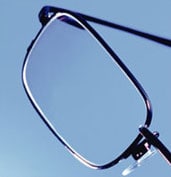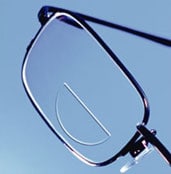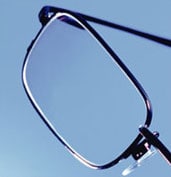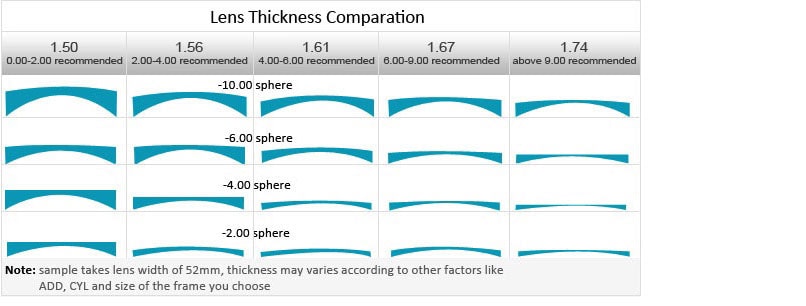Lenses Coatings
>> Professional lens Service
>> About Our Lenses Types
>> Available lenses index
>> Available lenses color tint
>> Our Coatings
Professional lens Service
GlassesShop is the largest online full-service eyewear store in the United States. We offer quality prescription lenses to any customer who buys glasses frames from us. This quality service is fast and offers breath-taking value compared to optical stores. We have licensed optical dispensers directly involved in every aspect of the daily running of the business. Each pair of prescription glasses will be made fitted with 100% accuracy and quality. It is easy and comfortable to buy prescription eyewear with us.
About Our Lenses Types

1Single Vision Lenses
Single Vision lenses are the standard eyeglass prescription. These glasses have only one viewing area throughout the entire lens and the correctional area can be for far distance, mid distance or reading.
Far distance- If you wear glasses all day, but don't have bi/varifocals or mostly need these glasses to see things in the distance.E.g. For driving.
Mid distance- If you mostly need these glasses for working on the computer or something else at arms length or you are a musician and need these glasses for reading music. Reading- If you need to read things close to you.Papers, document, etc
2Bifocal Lenses with a Line
A bifocal lens means a lens with two points of focus. A small portion of the eyeglass lens is reserved for the near-vision correction. The rest of the lens is usually a distance correction.
Generally, you look up and through the distance portion of the lens when focusing on points farther away, and you look down and through the bifocal segment of the lens when focusing on reading material or detail work up to about 18 inches away.
3Progressive Lenses - No Line
Progressive lenses are the closest to how natural vision is that you can get in a pair of prescription eyeglasses. They are more than just a defined near and distance correction in one lens. Rather, progressives provide a smooth transition from distance through intermediate to near, with all the in-between corrections included as well. This constant graduation of the prescription means that you can look up to see in the distance, look ahead to view your computer in the intermediate zone, and drop your gaze downward to read and do fine work comfortably close up.
Available lenses index
We offer lenses with different index. The higher the prescription, the thinner and lighter the lens recommended.
Plastic Lenses (Standard Index 1.50)-Most suitable for Low prescriptions of SPH (0 to +/-2.0) and CYL (0 to +/-1.5).If your prescription is higher, we recommend that you upgrade your lens.)
Thinner Lenses (Middle Index 1.56)-Work with Low-to-moderate prescriptions of SPH (+/-2.0 to +/-4.0) and CYL (+/-1.5 to +/-2.0). If your prescription exceeds this range, we recommend upgrading your lens to another high-Index lens.
Super Thin Lenses (High Index 1.61)-Thin & Light lenses offer the best value for people who have moderate prescriptions and want a light lens.It is suitable for prescriptions of SPH(+/-4.0 to +/-6.0 ),CYL(+/-2.25 to +/-3.0).
Ultra Thin Lenses (High Index 1.67)- These lenses are great for people with moderate-to-high prescriptions. And are recommended of prescriptions of SPH (+/-6.0 to +/-9.0), CYL (+/-3.25 to +/-4.0) for the best results.
Extreme Thin Lenses (High Index 1.74)- The thinnest and lightest lenses available on the optical market.These lenses are recommended for prescriptions of SPH above +/-9.0, CYL above +/-4.25.

Trivex (Middle index 1.56)- Trivex lenses are premium quality high impact resistance lenses with full UV protection, special strong anti-scratch coating.Trivex lenses give you all the performance you need: durability, UV protection, lightweight comfort and crisp clear vision.

Diamond Clear Polycarbonate (High Index 1.61) - Polycarbonate lenses are unique. They are stronger than the other lenses but is more prone to scratching and cannot be tinted or thinned. And they have the similar features as the Trives lenses using during sports.
Polarized Lenses (Index 1.50) - Polarized lenses are used in sunglasses to reduce glare from reflective surfaces such as the surface of a lake or the hood of a car. They accomplish this feat through a process called polarization, much like a venetian blind controls sunlight through a window.
Available lenses color tint
As opposed to the changeable photochromics, another option in colored lenses is a tint which remains constant at all times. Tints are available on our glasses with the following colors: green, brown, grey, blue, purple, and pink (available 20%, 40%, 60% and 80%). Lighter, fashion tints are used primarily for cosmetic purposes to enhance a wearer's looks. Darker tints allow the wearer to use the lenses as sunglasses

Photochromic lenses
Mid-index 1.56 Photochromic lenses
The difference between photochromic lenses and ordinary color lenses is that photochromic lenses can change from light to dark depending on the amount of ultraviolet light. This feature offers great comfort to eyeglass wearers.Photochromic lenses come with built-in anti-scratch, and 100% UV protection.

Transitions® Lenses

Transitions ® VI Lenses are brand photochromic lenses, which contain patented photochromic dyes. They are the smartest choice for your everyday lenses offering everything you need in a corrective lens:
• Visual acuity
• Visual comfort
• Convenient protection from the harmful effects of UV radiation and glare.
Our Coatings
Anti-Scratch Coating (Free)
Anti-Scratch coating for eyeglasses is a coating that is applied to lens surfaces. It helps to prevent minor scratches that can easily happen to a regular lens. These minor scratches can damage the surface of the lens and impair vision. An anti-scratch coating acts as a protective layer thus making the lenses more durable.
UV Coating
UV Coating is a beneficial lens treatment. It is an invisible dye that blocks ultraviolet (UV) light. Just as sunscreen keeps the sun's UV rays from harming your skin, UV-protective treatments for eyeglasses lenses block those same rays from damaging your eyes.
Anti-reflective coating for driving & Sport
As light encounters a lens three things happen. Some of the light passes through the lens, this is called refraction, some is absorbed and converted into heat energy (very small amounts) and the rest bounces off. When light bounces off the lens this creates glare. Glare or reflections can be annoying and in some severe cases can decrease visual acuity. To improve both the vision through the lenses and the appearance of the glasses, an anti-reflective coating (also called AR coating) is applied.
